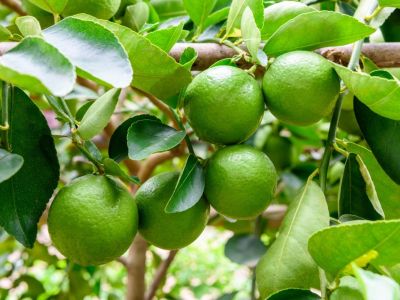Types of Lime Trees
Limes are closely related to lemons. They even look similar to them, especially once they have fully ripened. Until reaching maturity, limes are quite sour tasting. Unlike the lemon, though, the best lime tree harvest time is just before it turns yellow. Lime tree harvest is easier when you are familiar with the different types of lime trees and what they look like.
One of the most popular lime trees is the Key lime, or Mexican lime, (Citrus aurantifolia). This green lime grows somewhat small, only about 2 inches (5 cm.) in diameter. The Tahiti lime (Citrus latifolia), also known as Persian lime, is larger in appearance and more greenish yellow when ripe. Not considered a true lime, but worth mention is the Kaffir lime (Citrus hystrix), which puts out small dark green, bumpy-looking limes.
Lime Tree Care
When considering when limes are ripe, lime tree care should be taken into account. Lime trees are sensitive to cold, so keep them sheltered from wind and provide plenty of sunlight, especially if you want to harvest good sized fruit. Adequate drainage is also a necessity. You should see clusters of about five or six green limes forming once the blossoms have faded. In order to produce larger limes, however, you may want to thin this number down to only two or three.
Lime Tree Harvest Time
If lime tree harvest leaves you feeling a bit confused, you’re not alone. Many people are unsure about when to pick a lime from a tree. Limes are harvested prior to ripening, while the lime is still green. Limes are actually yellow once fully ripe but will be bitter and not taste very good when harvested yellow. To determine whether a green lime is ripe enough for harvesting, gently twist one from the stem of the lime tree and cut it open. Harvest time is appropriate if the fruit is juicy inside, otherwise, you’ll have to wait awhile longer. Also, try looking for limes that are light green as opposed to those which are darker in color and choose fruits that are smooth and slightly soft when gently squeezed. Green limes will not continue to ripen once picked, therefore, it’s usually best to leave them on the tree until needed, as green limes keep longer this way, unless you choose to freeze them. The juice can also be frozen, placing in ice cube trays and used as needed, which is especially helpful if fruit has fallen ripe from lime trees. Once limes begin taking on a wrinkled appearance, they have been left on the tree too long. They will eventually fall from lime trees as they turn yellow. Lime tree harvest generally takes place during summer. Limes take about three to four months until they reach peak flavor. However, in some regions (USDA plant hardiness zones 9-10), green limes can be harvested year-round.
